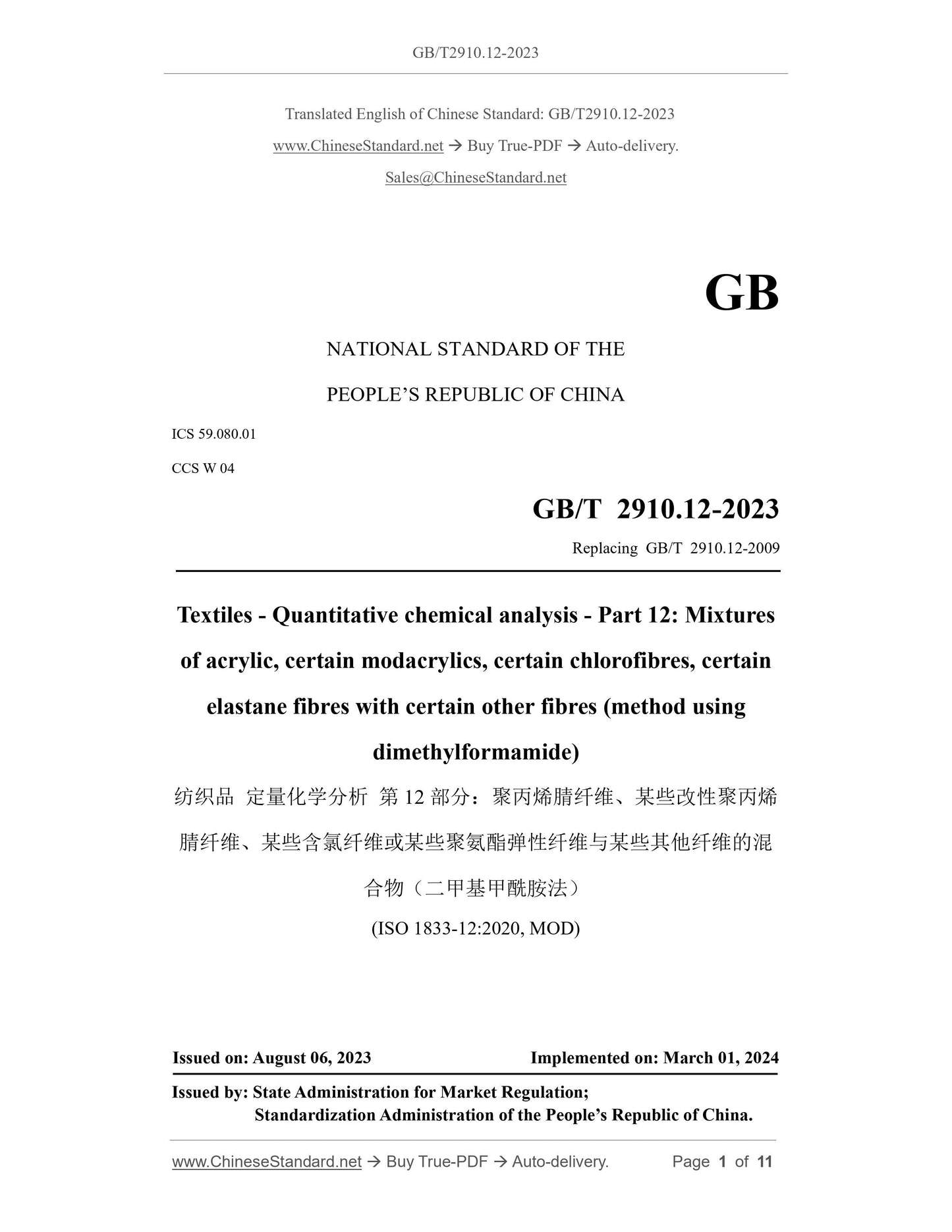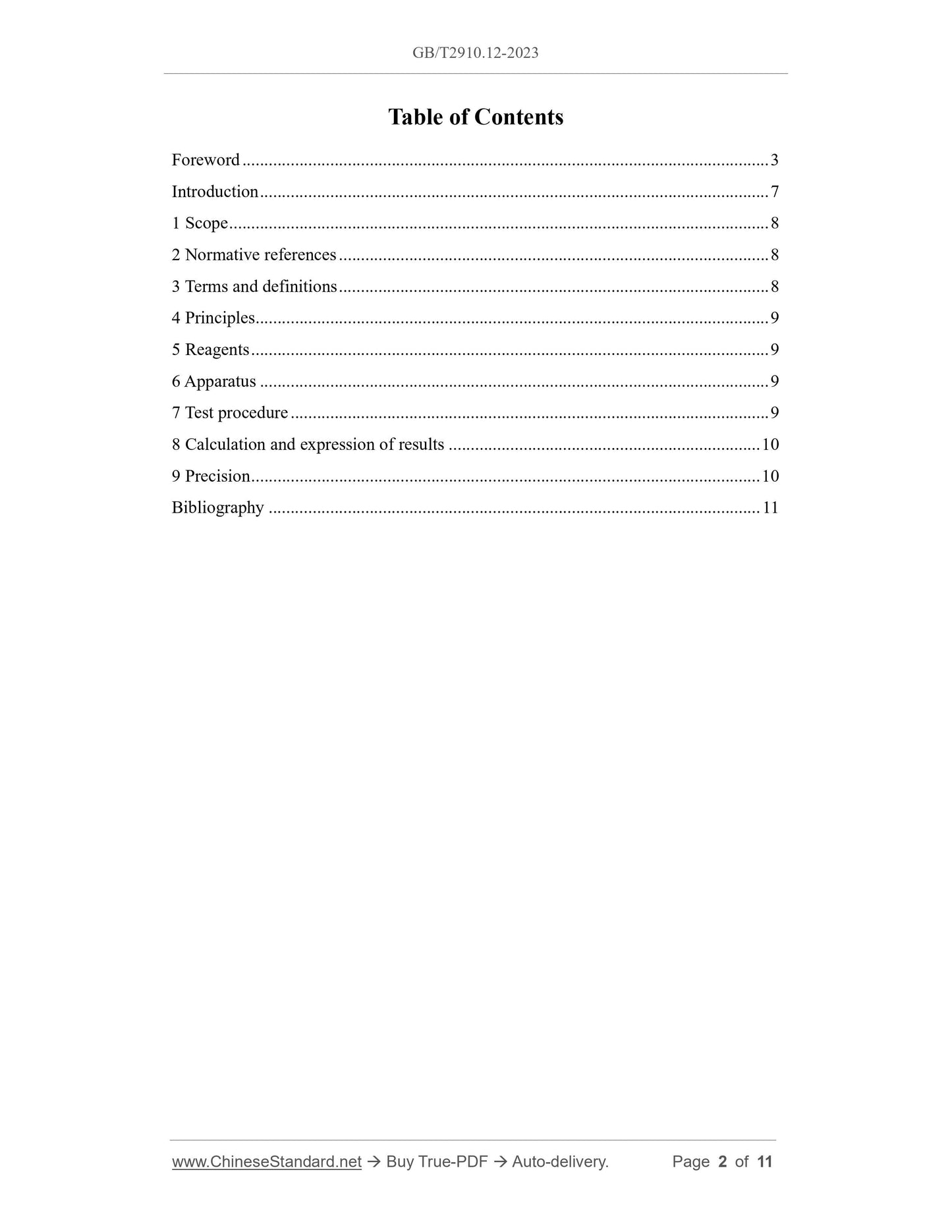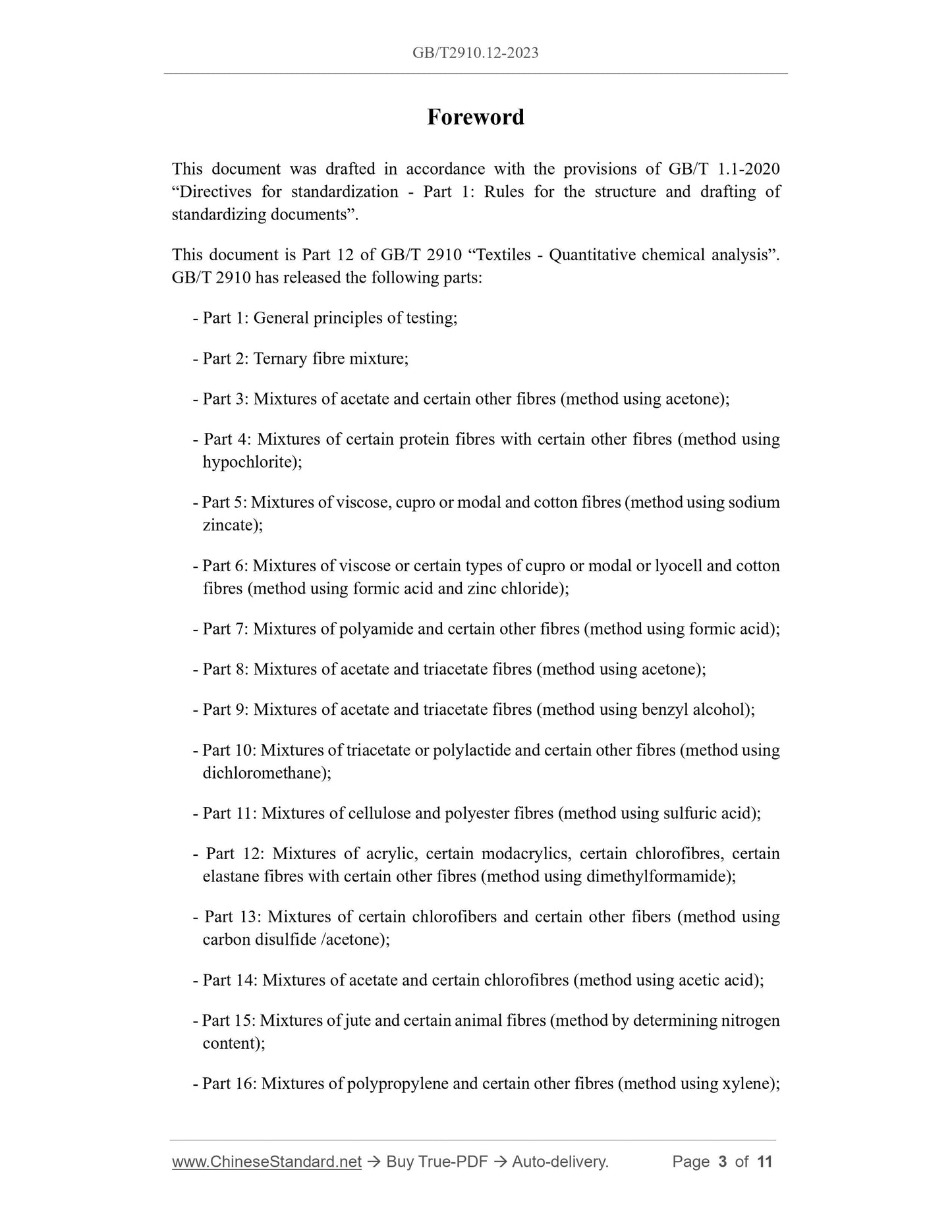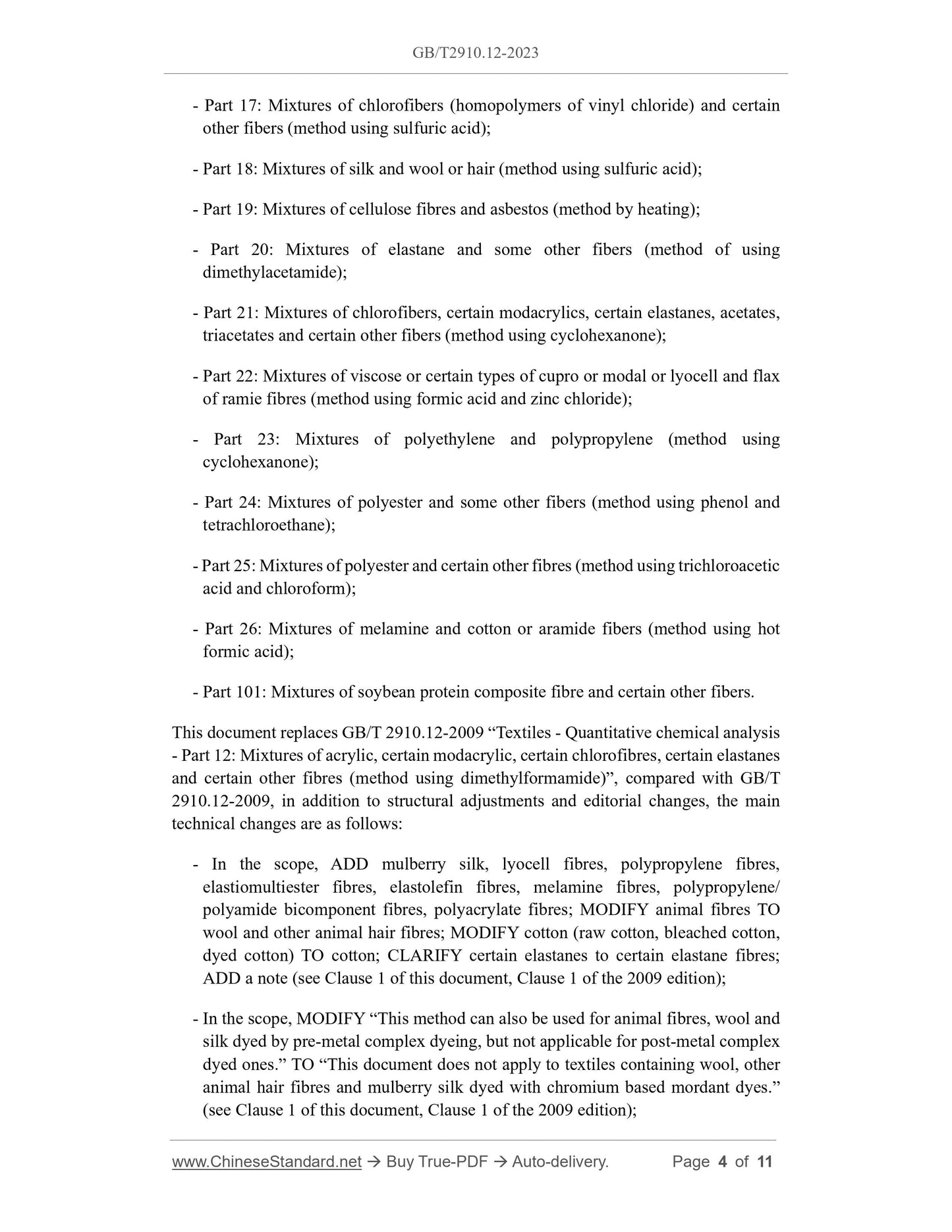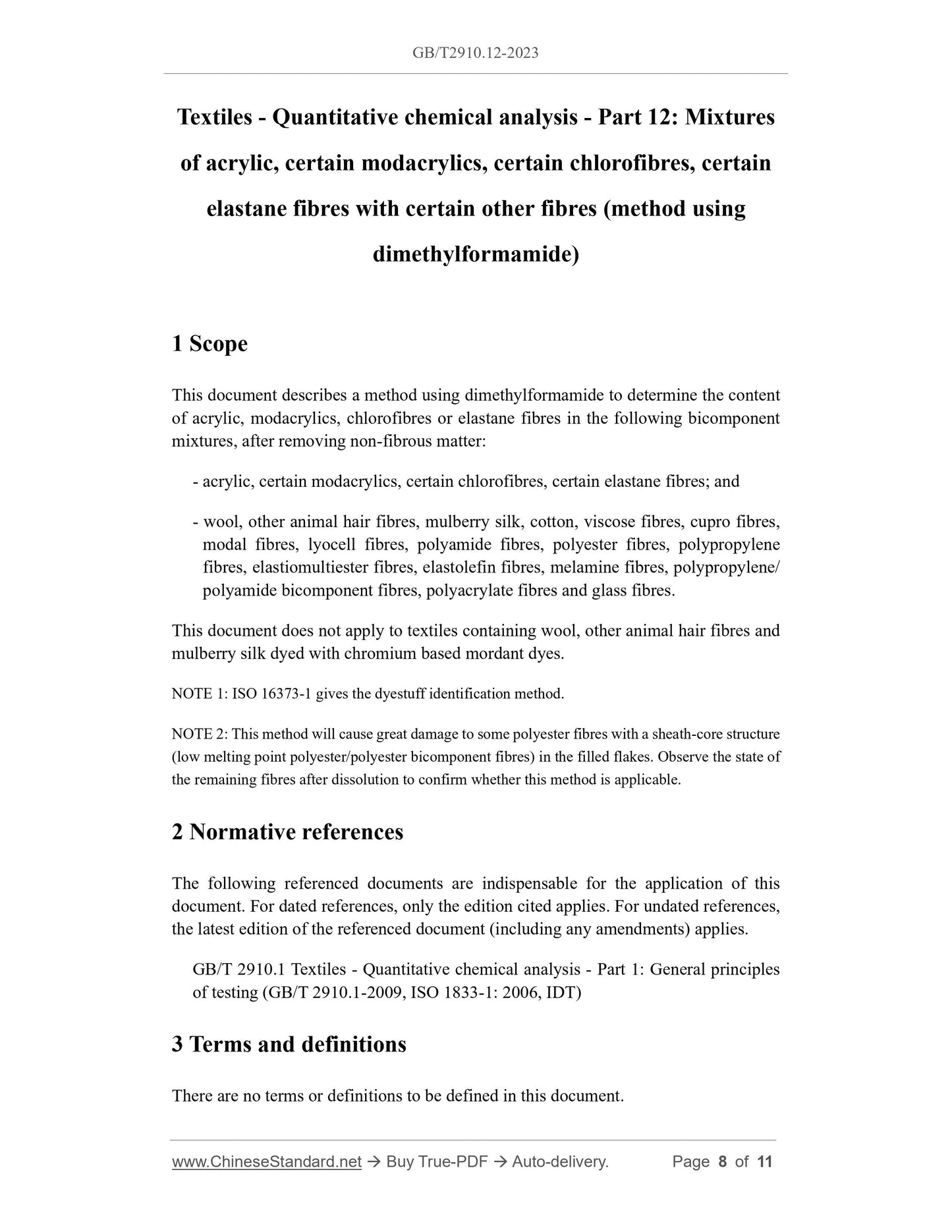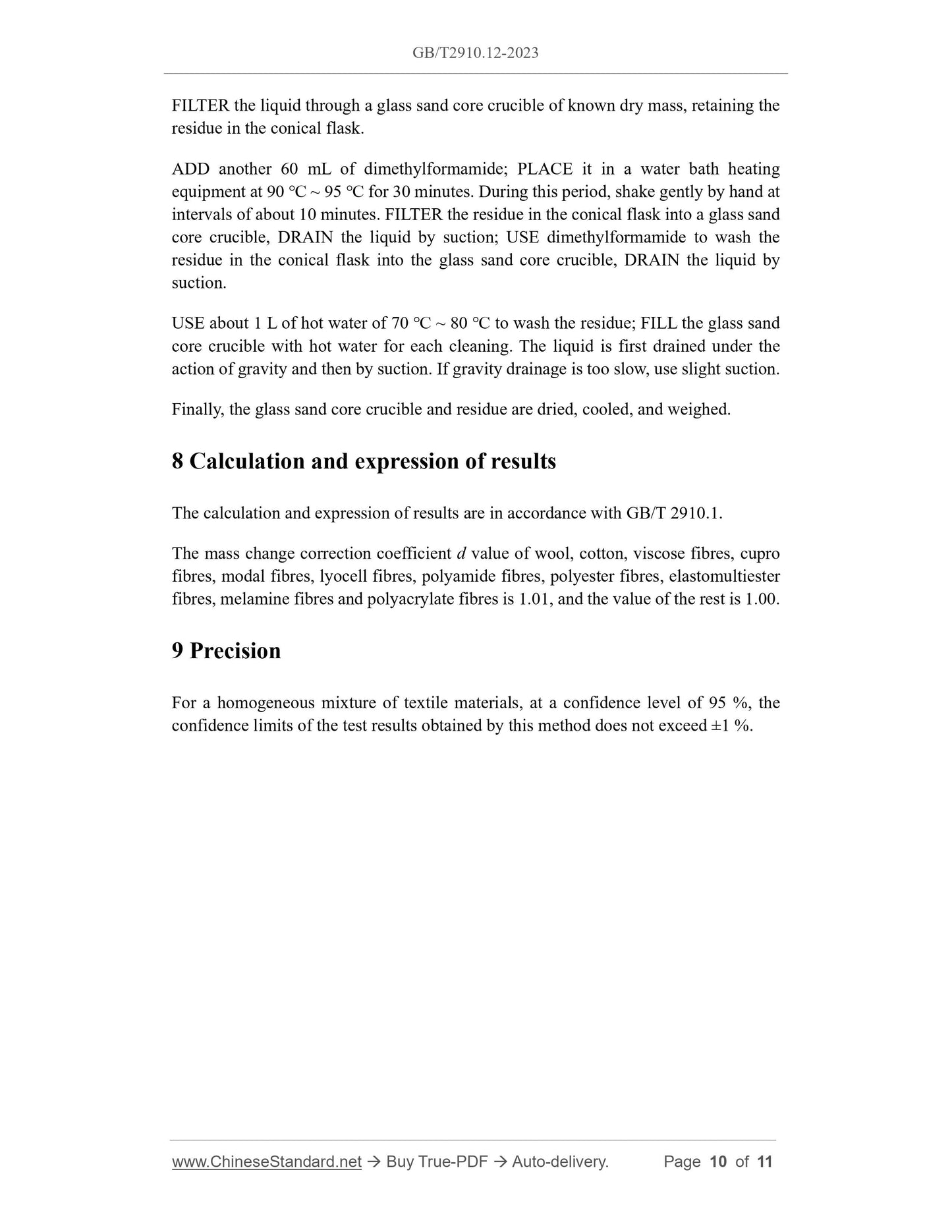1
/
of
6
PayPal, credit cards. Download editable-PDF and invoice in 1 second!
GB/T 2910.12-2023 English PDF (GBT2910.12-2023)
GB/T 2910.12-2023 English PDF (GBT2910.12-2023)
Regular price
$170.00 USD
Regular price
Sale price
$170.00 USD
Unit price
/
per
Shipping calculated at checkout.
Couldn't load pickup availability
Delivery: 3 seconds. Download true-PDF + Invoice.
Get QUOTATION in 1-minute: Click GB/T 2910.12-2023
Historical versions: GB/T 2910.12-2023
Preview True-PDF (Reload/Scroll if blank)
GB/T 2910.12-2023: Textiles - Quantitative chemical analysis - Part 12: Mixtures of acrylic, certain modacrylics, certain chlorofibres, certain elastane fibres with certain other fibres(method using dimethylformamide)
GB/T 2910.12-2023
GB
NATIONAL STANDARD OF THE
PEOPLE’S REPUBLIC OF CHINA
ICS 59.080.01
CCS W 04
GB/T 2910.12-2023
Replacing GB/T 2910.12-2009
Textiles - Quantitative chemical analysis - Part 12: Mixtures
of acrylic, certain modacrylics, certain chlorofibres, certain
elastane fibres with certain other fibres (method using
dimethylformamide)
(ISO 1833-12:2020, MOD)
ISSUED ON: AUGUST 06, 2023
IMPLEMENTED ON: MARCH 01, 2024
Issued by: State Administration for Market Regulation;
Standardization Administration of the People’s Republic of China.
Table of Contents
Foreword ... 3
Introduction ... 7
1 Scope ... 8
2 Normative references ... 8
3 Terms and definitions ... 8
4 Principles ... 9
5 Reagents ... 9
6 Apparatus ... 9
7 Test procedure ... 9
8 Calculation and expression of results ... 10
9 Precision ... 10
Bibliography ... 11
Foreword
This document was drafted in accordance with the provisions of GB/T 1.1-2020
“Directives for standardization - Part 1: Rules for the structure and drafting of
standardizing documents”.
This document is Part 12 of GB/T 2910 “Textiles - Quantitative chemical analysis”.
GB/T 2910 has released the following parts:
- Part 1: General principles of testing;
- Part 2: Ternary fibre mixture;
- Part 3: Mixtures of acetate and certain other fibres (method using acetone);
- Part 4: Mixtures of certain protein fibres with certain other fibres (method using
hypochlorite);
- Part 5: Mixtures of viscose, cupro or modal and cotton fibres (method using sodium
zincate);
- Part 6: Mixtures of viscose or certain types of cupro or modal or lyocell and cotton
fibres (method using formic acid and zinc chloride);
- Part 7: Mixtures of polyamide and certain other fibres (method using formic acid);
- Part 8: Mixtures of acetate and triacetate fibres (method using acetone);
- Part 9: Mixtures of acetate and triacetate fibres (method using benzyl alcohol);
- Part 10: Mixtures of triacetate or polylactide and certain other fibres (method using
dichloromethane);
- Part 11: Mixtures of cellulose and polyester fibres (method using sulfuric acid);
- Part 12: Mixtures of acrylic, certain modacrylics, certain chlorofibres, certain
elastane fibres with certain other fibres (method using dimethylformamide);
- Part 13: Mixtures of certain chlorofibers and certain other fibers (method using
carbon disulfide /acetone);
- Part 14: Mixtures of acetate and certain chlorofibres (method using acetic acid);
- Part 15: Mixtures of jute and certain animal fibres (method by determining nitrogen
content);
- Part 16: Mixtures of polypropylene and certain other fibres (method using xylene);
- Part 17: Mixtures of chlorofibers (homopolymers of vinyl chloride) and certain
other fibers (method using sulfuric acid);
- Part 18: Mixtures of silk and wool or hair (method using sulfuric acid);
- Part 19: Mixtures of cellulose fibres and asbestos (method by heating);
- Part 20: Mixtures of elastane and some other fibers (method of using
dimethylacetamide);
- Part 21: Mixtures of chlorofibers, certain modacrylics, certain elastanes, acetates,
triacetates and certain other fibers (method using cyclohexanone);
- Part 22: Mixtures of viscose or certain types of cupro or modal or lyocell and flax
of ramie fibres (method using formic acid and zinc chloride);
- Part 23: Mixtures of polyethylene and polypropylene (method using
cyclohexanone);
- Part 24: Mixtures of polyester and some other fibers (method using phenol and
tetrachloroethane);
- Part 25: Mixtures of polyester and certain other fibres (method using trichloroacetic
acid and chloroform);
- Part 26: Mixtures of melamine and cotton or aramide fibers (method using hot
formic acid);
- Part 101: Mixtures of soybean protein composite fibre and certain other fibers.
This document replaces GB/T 2910.12-2009 “Textiles - Quantitative chemical analysis
- Part 12: Mixtures of acrylic, certain modacrylic, certain chlorofibres, certain elastanes
and certain other fibres (method using dimethylformamide)”, compared with GB/T
2910.12-2009, in addition to structural adjustments and editorial changes, the main
technical changes are as follows:
- In the scope, ADD mulberry silk, lyocell fibres, polypropylene fibres,
elastiomultiester fibres, elastolefin fibres, melamine fibres, polypropylene/
polyamide bicomponent fibres, polyacrylate fibres; MODIFY animal fibres TO
wool and other animal hair fibres; MODIFY cotton (raw cotton, bleached cotton,
dyed cotton) TO cotton; CLARIFY certain elastanes to certain elastane fibres;
ADD a note (see Clause 1 of this document, Clause 1 of the 2009 edition);
- In the scope, MODIFY “This method can also be used for animal fibres, wool and
silk dyed by pre-metal complex dyeing, but not applicable for post-metal complex
dyed ones.” TO “This document does not apply to textiles containing wool, other
animal hair fibres and mulberry silk dyed with chromium based mordant dyes.”
(see Clause 1 of this document, Clause 1 of the 2009 edition);
Textiles - Quantitative chemical analysis - Part 12: Mixtures
of acrylic, certain modacrylics, certain chlorofibres, certain
elastane fibres with certain other fibres (method using
dimethylformamide)
1 Scope
This document describes a method using dimethylformamide to determine the content
of acrylic, modacrylics, chlorofibres or elastane fibres in the following bicomponent
mixtures, after removing non-fibrous matter:
- acrylic, certain modacrylics, certain chlorofibres, certain elastane fibres; and
- wool, other animal hair fibres, mulberry silk, cotton, viscose fibres, cupro fibres,
modal fibres, lyocell fibres, polyamide fibres, polyester fibres, polypropylene
fibres, elastiomultiester fibres, elastolefin fibres, melamine fibres, polypropylene/
polyamide bicomponent fibres, polyacrylate fibres and glass fibres.
This document does not apply to textiles containing wool, other animal hair fibres and
mulberry silk dyed with chromium based mordant dyes.
NOTE 1: ISO 16373-1 gives the dyestuff identification method.
NOTE 2: This method will cause great damage to some polyester fibres with a sheath-core structure
(low melting point polyester/polyester bicomponent fibres) in the filled flakes. Observe the state of
the remaining fibres after dissolution to confirm whether this method is applicable.
2 Normative references
The following referenced documents are indispensable for the application of this
document. For dated references, only the edition cited applies. For undated references,
the latest edition of the referenced document (including any amendments) applies.
GB/T 2910.1 Textiles - Quantitative chemical analysis - Part 1: General principles
of testing (GB/T 2910.1-2009, ISO 1833-1: 2006, IDT)
3 Terms and definitions
There are no terms or definitions to be defined in this document.
FILTER the liquid through a glass sand core crucible of known dry mass, retaining the
residue in the conical flask.
ADD another 60 mL of dimethylformamide; PLACE it in a water bath heating
equipment at 90 ℃ ~ 95 ℃ for 30 minutes. During this period, shake gently by hand at
intervals of about 10 minutes. FILTER the residue in the conical flask into a glass sand
core crucible, DRAIN the liquid by suction; USE dimethylformamide to wash the
residue in the conical flask into the glass sand core crucible, DRAIN the liquid by
suction.
USE about 1 L of hot water of 70 ℃ ~ 80 ℃ to wash t...
Get QUOTATION in 1-minute: Click GB/T 2910.12-2023
Historical versions: GB/T 2910.12-2023
Preview True-PDF (Reload/Scroll if blank)
GB/T 2910.12-2023: Textiles - Quantitative chemical analysis - Part 12: Mixtures of acrylic, certain modacrylics, certain chlorofibres, certain elastane fibres with certain other fibres(method using dimethylformamide)
GB/T 2910.12-2023
GB
NATIONAL STANDARD OF THE
PEOPLE’S REPUBLIC OF CHINA
ICS 59.080.01
CCS W 04
GB/T 2910.12-2023
Replacing GB/T 2910.12-2009
Textiles - Quantitative chemical analysis - Part 12: Mixtures
of acrylic, certain modacrylics, certain chlorofibres, certain
elastane fibres with certain other fibres (method using
dimethylformamide)
(ISO 1833-12:2020, MOD)
ISSUED ON: AUGUST 06, 2023
IMPLEMENTED ON: MARCH 01, 2024
Issued by: State Administration for Market Regulation;
Standardization Administration of the People’s Republic of China.
Table of Contents
Foreword ... 3
Introduction ... 7
1 Scope ... 8
2 Normative references ... 8
3 Terms and definitions ... 8
4 Principles ... 9
5 Reagents ... 9
6 Apparatus ... 9
7 Test procedure ... 9
8 Calculation and expression of results ... 10
9 Precision ... 10
Bibliography ... 11
Foreword
This document was drafted in accordance with the provisions of GB/T 1.1-2020
“Directives for standardization - Part 1: Rules for the structure and drafting of
standardizing documents”.
This document is Part 12 of GB/T 2910 “Textiles - Quantitative chemical analysis”.
GB/T 2910 has released the following parts:
- Part 1: General principles of testing;
- Part 2: Ternary fibre mixture;
- Part 3: Mixtures of acetate and certain other fibres (method using acetone);
- Part 4: Mixtures of certain protein fibres with certain other fibres (method using
hypochlorite);
- Part 5: Mixtures of viscose, cupro or modal and cotton fibres (method using sodium
zincate);
- Part 6: Mixtures of viscose or certain types of cupro or modal or lyocell and cotton
fibres (method using formic acid and zinc chloride);
- Part 7: Mixtures of polyamide and certain other fibres (method using formic acid);
- Part 8: Mixtures of acetate and triacetate fibres (method using acetone);
- Part 9: Mixtures of acetate and triacetate fibres (method using benzyl alcohol);
- Part 10: Mixtures of triacetate or polylactide and certain other fibres (method using
dichloromethane);
- Part 11: Mixtures of cellulose and polyester fibres (method using sulfuric acid);
- Part 12: Mixtures of acrylic, certain modacrylics, certain chlorofibres, certain
elastane fibres with certain other fibres (method using dimethylformamide);
- Part 13: Mixtures of certain chlorofibers and certain other fibers (method using
carbon disulfide /acetone);
- Part 14: Mixtures of acetate and certain chlorofibres (method using acetic acid);
- Part 15: Mixtures of jute and certain animal fibres (method by determining nitrogen
content);
- Part 16: Mixtures of polypropylene and certain other fibres (method using xylene);
- Part 17: Mixtures of chlorofibers (homopolymers of vinyl chloride) and certain
other fibers (method using sulfuric acid);
- Part 18: Mixtures of silk and wool or hair (method using sulfuric acid);
- Part 19: Mixtures of cellulose fibres and asbestos (method by heating);
- Part 20: Mixtures of elastane and some other fibers (method of using
dimethylacetamide);
- Part 21: Mixtures of chlorofibers, certain modacrylics, certain elastanes, acetates,
triacetates and certain other fibers (method using cyclohexanone);
- Part 22: Mixtures of viscose or certain types of cupro or modal or lyocell and flax
of ramie fibres (method using formic acid and zinc chloride);
- Part 23: Mixtures of polyethylene and polypropylene (method using
cyclohexanone);
- Part 24: Mixtures of polyester and some other fibers (method using phenol and
tetrachloroethane);
- Part 25: Mixtures of polyester and certain other fibres (method using trichloroacetic
acid and chloroform);
- Part 26: Mixtures of melamine and cotton or aramide fibers (method using hot
formic acid);
- Part 101: Mixtures of soybean protein composite fibre and certain other fibers.
This document replaces GB/T 2910.12-2009 “Textiles - Quantitative chemical analysis
- Part 12: Mixtures of acrylic, certain modacrylic, certain chlorofibres, certain elastanes
and certain other fibres (method using dimethylformamide)”, compared with GB/T
2910.12-2009, in addition to structural adjustments and editorial changes, the main
technical changes are as follows:
- In the scope, ADD mulberry silk, lyocell fibres, polypropylene fibres,
elastiomultiester fibres, elastolefin fibres, melamine fibres, polypropylene/
polyamide bicomponent fibres, polyacrylate fibres; MODIFY animal fibres TO
wool and other animal hair fibres; MODIFY cotton (raw cotton, bleached cotton,
dyed cotton) TO cotton; CLARIFY certain elastanes to certain elastane fibres;
ADD a note (see Clause 1 of this document, Clause 1 of the 2009 edition);
- In the scope, MODIFY “This method can also be used for animal fibres, wool and
silk dyed by pre-metal complex dyeing, but not applicable for post-metal complex
dyed ones.” TO “This document does not apply to textiles containing wool, other
animal hair fibres and mulberry silk dyed with chromium based mordant dyes.”
(see Clause 1 of this document, Clause 1 of the 2009 edition);
Textiles - Quantitative chemical analysis - Part 12: Mixtures
of acrylic, certain modacrylics, certain chlorofibres, certain
elastane fibres with certain other fibres (method using
dimethylformamide)
1 Scope
This document describes a method using dimethylformamide to determine the content
of acrylic, modacrylics, chlorofibres or elastane fibres in the following bicomponent
mixtures, after removing non-fibrous matter:
- acrylic, certain modacrylics, certain chlorofibres, certain elastane fibres; and
- wool, other animal hair fibres, mulberry silk, cotton, viscose fibres, cupro fibres,
modal fibres, lyocell fibres, polyamide fibres, polyester fibres, polypropylene
fibres, elastiomultiester fibres, elastolefin fibres, melamine fibres, polypropylene/
polyamide bicomponent fibres, polyacrylate fibres and glass fibres.
This document does not apply to textiles containing wool, other animal hair fibres and
mulberry silk dyed with chromium based mordant dyes.
NOTE 1: ISO 16373-1 gives the dyestuff identification method.
NOTE 2: This method will cause great damage to some polyester fibres with a sheath-core structure
(low melting point polyester/polyester bicomponent fibres) in the filled flakes. Observe the state of
the remaining fibres after dissolution to confirm whether this method is applicable.
2 Normative references
The following referenced documents are indispensable for the application of this
document. For dated references, only the edition cited applies. For undated references,
the latest edition of the referenced document (including any amendments) applies.
GB/T 2910.1 Textiles - Quantitative chemical analysis - Part 1: General principles
of testing (GB/T 2910.1-2009, ISO 1833-1: 2006, IDT)
3 Terms and definitions
There are no terms or definitions to be defined in this document.
FILTER the liquid through a glass sand core crucible of known dry mass, retaining the
residue in the conical flask.
ADD another 60 mL of dimethylformamide; PLACE it in a water bath heating
equipment at 90 ℃ ~ 95 ℃ for 30 minutes. During this period, shake gently by hand at
intervals of about 10 minutes. FILTER the residue in the conical flask into a glass sand
core crucible, DRAIN the liquid by suction; USE dimethylformamide to wash the
residue in the conical flask into the glass sand core crucible, DRAIN the liquid by
suction.
USE about 1 L of hot water of 70 ℃ ~ 80 ℃ to wash t...
Share
